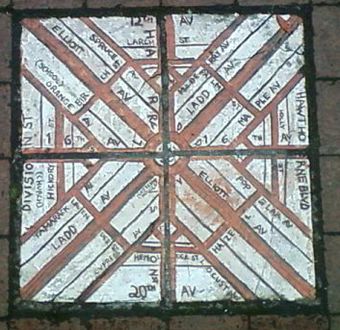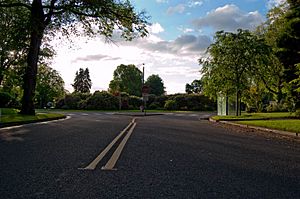Ladd's Addition facts for kids
Quick facts for kids |
|
|
Ladd's Addition Historic District
|
|

Brick map of Ladd's Addition at the corner of SE 34th Avenue and SE Madison Street
|
|
| Location | Portland, Oregon |
|---|---|
| Area | 126 acres (0.51 km2) |
| Built | 1905–1930 |
| NRHP reference No. | 88001310 |
| Added to NRHP | August 31, 1988 |
Ladd's Addition is a historic neighborhood in southeast Portland, Oregon. It is Portland's oldest planned residential development. It is also one of the oldest planned neighborhoods in the western United States.
This district is famous in Portland for its unique street pattern. Unlike most areas with straight, grid-like streets, Ladd's Addition has diagonal streets. It covers about eight blocks east-west and ten blocks north-south. The neighborhood is bordered by SE Hawthorne, Division, 12th, and 20th streets. It is part of the Hosford-Abernethy neighborhood.
History of Ladd's Addition
Ladd's Addition is named after William S. Ladd. He was a businessman and a mayor of Portland in the mid-1800s. Ladd owned a large farm of about 126 acres on this land.
In 1891, the city of East Portland joined with Portland. After this, William Ladd decided to divide his land into smaller pieces for homes. Instead of using the usual straight grid pattern, Ladd created a special "wagon wheel" design. This design includes four small, diamond-shaped rose gardens. It also has a central traffic circle that surrounds a park.
Ladd's Addition is also one of the few places in Portland with alleyways. This means that the main streets have fewer curb cuts for driveways. This gives the streets a more continuous look.
Most of the homes in Ladd's Addition were built between 1905 and 1930. They are known for their beautiful and varied architectural styles. These styles include bungalow, Craftsman, American Foursquare, Mission, Tudor, and Colonial Revival. The homes were built with similar sizes and materials, which gives the neighborhood a consistent feel.
The first homes were built in the northern part of the neighborhood. This area was closest to the streetcar lines, making it easy for people to travel. The largest homes were built between 1905 and 1915.
Ecology and Gardens
The narrow streets of Ladd's Addition are lined with many American Elm trees. These trees are very important to the neighborhood. A group called "Save Our Elms" helps protect them. They give the elm trees a special treatment each year to prevent Dutch elm disease.
Each of the four smaller, diamond-shaped "circles" in the neighborhood contains one of Portland's rose test gardens. These gardens are beautiful and well-loved. The "Friends of Ladd's Addition Gardens" group works hard to maintain them. They ask for money and volunteers to help keep the rose gardens looking great.
William Ladd named most of the streets in the neighborhood after different types of trees. However, he named SE Ladd Avenue after himself. He also named SE Elliott Avenue after his wife, Caroline Elliott.
Historic Preservation
Ladd's Addition was officially recognized as a historic district in 1988. This means it is a special area with historical importance. It was added to the National Register of Historic Places. This listing helps protect the unique character and history of the neighborhood for future generations.



